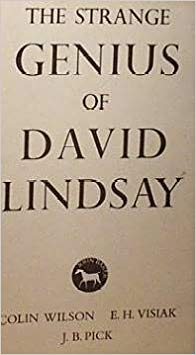 By COLIN WILSON, J.B. PICK, E.H. VISIAK (John Baker; 1970)
By COLIN WILSON, J.B. PICK, E.H. VISIAK (John Baker; 1970)
This slim three author compilation was the first-ever study of the English fantasist David Lindsay, author of the immortal VOYAGE TO ARCTURUS, THE HAUNTED WOMAN and several other eccentric novels. The aptly titled STRANGE GENIUS OF DAVID LINDSAY was initiated by Colin Wilson, who believes Lindsay is “one of most important writers of this century.” The intent was to combine critical and biographical details about Lindsay and his fiction through essays by Wilson and E.H. Visiak, who actually knew Lindsay in the final years of his life. J.B. Pick, who befriended Lindsay’s widow in her final years, fills out the book with his own thoughts on David Lindsay’s fiction. Their combined efforts make for a generally satisfying volume for Lindsay fans, although it isn’t quite the “definitive work” on Lindsay that Wilson promises in his introduction.
I’m not sure Wilson is correct in his assessment of David Lindsay as one of the “most important” 20th Century novelists, but he was certainly among the most fascinating and enigmatic. Lindsay was an indisputably great thinker, with philosophical and metaphysical concerns as learned and developed as those of nearly any philosopher, yet he was stymied by the fact that, frankly, he was a lousy writer. Indeed, Lindsay’s painfully arch prose is a constant irritant in all his fiction, and the likely reason his work is so widely misunderstood. The value of this book is that it provides a (mostly) coherent appraisal of its subject’s talents. It’s a shame, then, that THE STRANGE GENIUS OF DAVID LINDSAY is long out of print and now an expensive collector’s item.
Colin Wilson’s contributions consist of the aforementioned introduction and a lengthy essay that focuses mostly on A VOYAGE TO ARCTURUS. It’s the best written of the book’s entries, and was later published in standalone form (as HAUNTED MAN: THE STRANGE GENIUS OF DAVID LINDSAY).
E.H. Visiak’s contributions, alas, are quite disappointing, being far more illuminating about Visiak’s own obsessions than those of David Lindsay. Visiak was an authority on Milton, and in one of his essays insists on viewing A VOYAGE TO ARCTURUS as a Milton-esque Christian allegory, even though Visiak concedes at the start of the piece that Lindsay would have staunchly rejected any such interpretation. Visiak also contributes a detailed summary of Lindsay’s 1932 novel DEVIL’S TOR, complete with lengthy quotes—ideal reading, I guess, for those who haven’t read DEVIL’S TOR, but pretty useless to those (like me) who have.
As for J.B. Pick, he provides a largely satisfying biographical sketch of Lindsay—unsurprisingly, he was an apparently tormented man who in his lifetime never achieved the literary success he deserved. Pick also summarizes Lindsay’s novels THE VIOLET APPLE and THE WITCH, which in 1970 had yet to see publication.
Perhaps the most unfortunate aspect of the David Lindsay saga is the scarceness of most of his novels. Wilson states herein that he hopes someday to see all of Lindsay’s fiction in print, and yet, while A VOYAGE TO ARCTURUS and THE HAUNTED WOMAN are both readily available, much of the rest of Lindsay’s oeuvre (despite scattered republications over the years) is now as obscure as this book.
